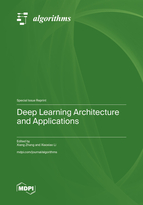Deep Learning Architecture and Applications
A special issue of Algorithms (ISSN 1999-4893). This special issue belongs to the section "Evolutionary Algorithms and Machine Learning".
Deadline for manuscript submissions: closed (10 March 2023) | Viewed by 60465
Special Issue Editors
2. Department of Computer Science, University of North Carolina at Charlotte, Charlotte, NC 28223, USA
Interests: machine learning; medical time series; brain–computer interface; graph neural networks; pervasive healthcare
Special Issue Information
Dear Colleagues,
As one of the fastest-growing topics in machine learning, deep learning algorithms have achieved unprecedented success in recent years. Novel paradigms (such as contrastive learning and few-shot learning) in deep learning and rising neural network architectures (e.g., transformer, masked autoencoder) are dramatically changing the landscape of data-driven algorithms. More importantly, deep learning models, serving as powerful tools, are redefining the next generation of industrial applications spanning image recognition, speech processing, language translation, healthcare, and even sciences. For example, recent advances in deep representation learning are extending the frontiers of human knowledge on protein 3D structures, which sheds new light on fundamental medicine and biology along with potentially bringing in billions of dollars (e.g., in the pharmaceutical market).
This Special Issue aims to supply a platform for the publication of novel deep learning algorithms/frameworks and their applications in real-world scenarios. The topics include but are not limited to the following:
- Supervised learning
- Unsupervised learning
- Reinforcement learning
- Explainability, generability, robustness, and fairness in deep learning
- Applications of deep learning
- Deep learning for health
- Deep learning for sciences
Dr. Xiang Zhang
Dr. Xiaoxiao Li
Guest Editors
Manuscript Submission Information
Manuscripts should be submitted online at www.mdpi.com by registering and logging in to this website. Once you are registered, click here to go to the submission form. Manuscripts can be submitted until the deadline. All submissions that pass pre-check are peer-reviewed. Accepted papers will be published continuously in the journal (as soon as accepted) and will be listed together on the special issue website. Research articles, review articles as well as short communications are invited. For planned papers, a title and short abstract (about 100 words) can be sent to the Editorial Office for announcement on this website.
Submitted manuscripts should not have been published previously, nor be under consideration for publication elsewhere (except conference proceedings papers). All manuscripts are thoroughly refereed through a single-blind peer-review process. A guide for authors and other relevant information for submission of manuscripts is available on the Instructions for Authors page. Algorithms is an international peer-reviewed open access monthly journal published by MDPI.
Please visit the Instructions for Authors page before submitting a manuscript. The Article Processing Charge (APC) for publication in this open access journal is 1600 CHF (Swiss Francs). Submitted papers should be well formatted and use good English. Authors may use MDPI's English editing service prior to publication or during author revisions.






